Balls and Walnuts
more than you ever wanted to know
Magic Schoolbus does your nose and throat
Michelle writes:
When Docs stick the thingamabob up your nose, what exactly do they see?
Here’s the side view. If this thing looks utterly foreign to you, take the time to note the nose, lips, and tongue, and then try to make sense out of everything else.
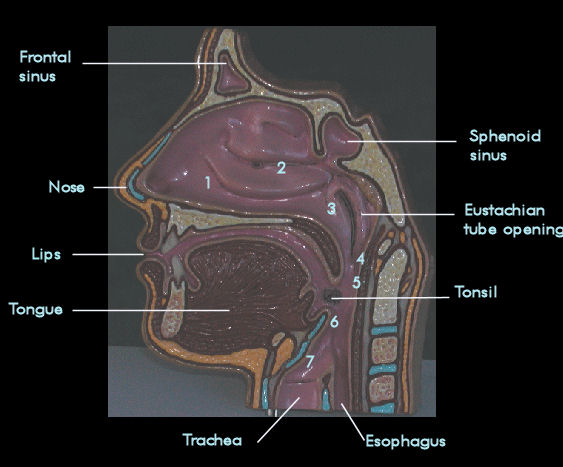
In a moment, I’ll be passing a fiberoptic laryngoscope down your nose. Don’t worry, I’ll put some cotton coated with lidocaine up there first, so the scope won’t cause you any pain. It’s the stuffing-your-nose-with-cotton part you should worry about.The numbers correspond to the position of the scope for each of the photos shown below. Ready? Let’s begin.
Oops, sorry about that. When I pull out the cotton, I usually try not to yank nasal hairs, too. It won’t happen again.
1. Anterior nasal cavity

F = nasal floor.
S = nasal septum. This is the sheet of cartilage, bone, and mucosa which divides your nose into two chambers. The anterior septum (this bit) is the most common site of nose bleeds. Don’t pick it.
T = inferior turbinate. When you have a stuffy nose, this sucker’s to blame. It’s made up of erectile tissue, just like the penis, clitoris, and nipples! (And you all thought I couldn’t sexualize the nose.) The turbinates help to humidify, filter, and warm the air we breathe.
2. Posterior nasal cavity
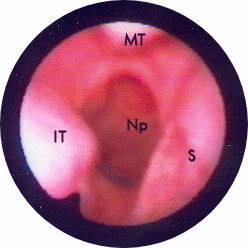
IT = inferior turbinate, and MT = middle turbinate. Between these two is the middle meatus (not labeled). Many sinuses drain via the middle meatus. Pus or polyps in this area are Not Good.
S = posterior nasal septum.
Np = nasopharynx. Think of it as the roof of your throat.
3. Nasopharynx

The camera has curved a bit; that dark area at the bottom of the photo is the lower part of the throat. We’re about to make a right angle turn downward, and I’m about to find out how active your gag reflex is. Don’t worry, no one has thrown up on me since 1993.
ETO = Eustachian tube orifice. The Eustachian tube is the thing you pop when you pop your ears. Here you see the connection between the ears, nose, and throat. Any trouble here (whether it be sinus drainage or a sore throat) can spill over, causing ear disease.
The nasopharynx is common site of cancer among people indigenous to mainland China.
4. Oropharynx
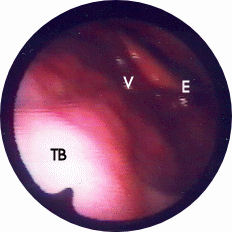
We’ve made the turn, and now we’re headed for Uranus.
Sorry. This page needed at least one juvenile pun. In any case, the scope isn’t long enough to reach Uranus. It isn’t even long enough to reach your anus.
TB = tongue base — the “root” of your tongue. Not a good place to get a tumor, which is why you really need to stop smoking NOW.
E = epiglottis, a leaf-shaped cartilage which protects the airway when you swallow.
V = vallecula (Latin for valley, if I’m not mistaken), the valley between the epiglottis and the tongue base. Another bad place for tumors. You ask: is there a good place for tumors? As a matter of fact, yes, there is. More on that below.
5. Upper hypopharynx

PPW = posterior pharyngeal wall (the back of the throat).
TB = tongue base.
E = epiglottis.
G = that dark hole is the glottis — the vocal cords. You’ll get a better look in a moment.
6. Lower hypopharynx
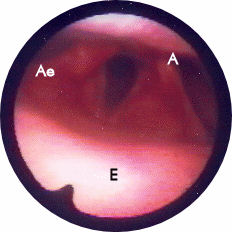
The closer the tip of the scope comes to a structure, the more it magnifies that structure. That’s why the epiglottis (E) looks so huge.
Do you see that V near the center of the photo? Those are the vocal cords. Between them is your airway, below them, your trachea (windpipe). The vocal cords are each attached to a pyramidal cartilage known as the arytenoid (A). Muscles attached to the arytenoids help move the vocal cords. Slender folds of mucosa connect the arytenoids to the epiglottis. These are the aryepiglottic folds (Ae).
This is what the vocal cords look like during quiet breathing. When you speak, cough, or swallow, the vocal cords come together, and you can no longer see the trachea.
7. Larynx
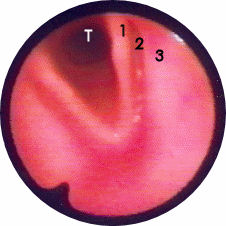
T = trachea.
Here you see the true vocal cords (the left true vocal cord is labeled 1), the false vocal folds (the left is labeled 3), and the laryngeal ventricle (2), a potential space between the true cords and the false vocal folds.
Vocal cord tumors present early, thanks to the fact that even a small tumor will produce a hoarse voice. Due to limited lymphatic drainage from the vocal cords, tumors can grow quite a bit here before they spread to other parts of the body. Thanks to their early presentation and limited ability to spread, cancers here are very treatable. Radiation therapy yields excellent results, both in terms of survival and voice quality.
Chronic hoarseness warrants a fiberoptic exam. The goal here is to catch the tumor while it is still limited to the vocal cord. Once it leaps up to the false vocal fold or descends down into the trachea, the survival stats deteriorate.
Most victims of throat cancer are big-time smokers and drinkers. Cancer risk (based on lung cancer data) starts dropping the day you quit smoking. Do it.
How’s that for a public service announcement? Now, no one can say Balls and Walnuts isn’t educational.
D.
[…] Magic Schoolbus does your nose and throat […]